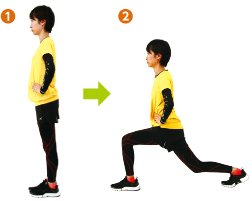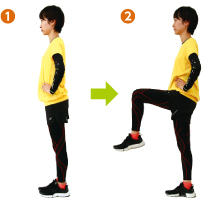SPORTS YOKOHAMA Vol.33:Feature(2/4)
![]()
 There are four objectives of warming up. A warm-up helps you (1) raise the temperature of the entire body; (2) get the cardiorespiratory system ready; (3) coordinate the nerves and muscles of the entire body to ensure good running form; and (4) check the fatigue level of the muscles and tendons to prevent injury. Keep these objectives in mind when warming up.
There are four objectives of warming up. A warm-up helps you (1) raise the temperature of the entire body; (2) get the cardiorespiratory system ready; (3) coordinate the nerves and muscles of the entire body to ensure good running form; and (4) check the fatigue level of the muscles and tendons to prevent injury. Keep these objectives in mind when warming up.
Here are two sets of exercises that are effective in meeting objective (3). These exercises stimulate the muscles you are going to use when running and get them ready for the run. Try them before hitting the road, in a way you feel comfortable with.
Hip joint swinging
1 Stand upright. 2 Put your right leg forward, and swing your hip joints back and forth. Repeat this with the left and right legs alternately 10 times each.

Thigh lifting
1 Stand upright. 2 Lift your right thigh.
When doing this, make sure you feel the muscles stretched from the lower back to the thigh. Repeat this with the left and right legs alternately 10 times each.

Running Program for Beginners
What should novice runners do to practice running? The chart at right shows a model running program developed based on the book called “Lore of Running” (written by Tim Noakes, translated by Japan Running Society and published by Taishukan Company). A survey conducted by the Sports Medical Center shows that people who start practicing running with this program are less prone to injury than those who start with full-fledged running practices.
The first six weeks of the program are focused on walking to develop the basic physical fitness necessary to keep the body moving for a long time. This period of time is also intended for you to check whether you are physically fit enough to run (e.g., the heart condition). The program helps you control the urge to run prematurely. Putting an excessive training load on the body at a premature stage may lead to injury, which makes you unable to practice for a while. In order to develop the basic physical fitness for running, it is vital to start your training with walking.
Those of you who look to run in a marathon may want to do longer running practices. But remember, when you are a week away from the race, shift the focus to reducing the fatigue from the training you have done till then. If you keep training hard until just before the race, chances are that the accumulated fatigue will affect your performance. So, from a week before the race, focus your training on stretching and short running practices.
Running Program * Run at the pace you feel comfortable with (5 to 7 minutes/km).
Practice by day of week Mon Tue Wed Thu Fri Sat Sun
From the 1st to 6th weeks![]() 20 minutes of walking
20 minutes of walking
![]() –
– ![]() –
– ![]() –
– ![]()
From the 7th to 12th weeks ![]() 20 minutes of walking
20 minutes of walking
+
![]() 10 minutes of running
10 minutes of running
![]()
![]()
![]()
![]()
–
![]()
![]()
–
![]()
![]()
– From the 13th to 16th weeks
![]() 10 minutes of walking
10 minutes of walking
+
![]() 20 minutes of running
20 minutes of running
![]()
![]()
![]()
![]()
–
![]()
![]()
![]()
![]()
![]()
![]()
–
From the 17th week and after
![]() 20 to 30 minutes of running
20 to 30 minutes of running
![]()
![]() –
– ![]()
![]()
![]() – Additional training for those looking to run in a marathon
– Additional training for those looking to run in a marathon
From the 24th to 29th weeks
![]() 20 to 30 minutes of running
20 to 30 minutes of running
![]() 40 to 60 minutes of running
40 to 60 minutes of running
![]()
![]()
![]()
![]() –
– ![]() –
–
From the 30th week and after
![]() 30 to 40 minutes of running
30 to 40 minutes of running
![]() 70 to 120 minutes of running
70 to 120 minutes of running
![]()
![]()
![]()
![]()
![]()
![]() –
–
One week before the race
![]() 20 to 30 minutes of running
20 to 30 minutes of running
![]()
![]()
![]() – – –
– – –
![]()
Day of
the race
![]()
 There are four objectives of warming up. A warm-up helps you (1) raise the temperature of the entire body; (2) get the cardiorespiratory system ready; (3) coordinate the nerves and muscles of the entire body to ensure good running form; and (4) check the fatigue level of the muscles and tendons to prevent injury. Keep these objectives in mind when warming up.
There are four objectives of warming up. A warm-up helps you (1) raise the temperature of the entire body; (2) get the cardiorespiratory system ready; (3) coordinate the nerves and muscles of the entire body to ensure good running form; and (4) check the fatigue level of the muscles and tendons to prevent injury. Keep these objectives in mind when warming up.
Here are two sets of exercises that are effective in meeting objective (3). These exercises stimulate the muscles you are going to use when running and get them ready for the run. Try them before hitting the road, in a way you feel comfortable with.
Hip joint swinging
1 Stand upright. 2 Put your right leg forward, and swing your hip joints back and forth. Repeat this with the left and right legs alternately 10 times each.

Thigh lifting
1 Stand upright. 2 Lift your right thigh.
When doing this, make sure you feel the muscles stretched from the lower back to the thigh. Repeat this with the left and right legs alternately 10 times each.

Running Program for Beginners
What should novice runners do to practice running? The chart at right shows a model running program developed based on the book called “Lore of Running” (written by Tim Noakes, translated by Japan Running Society and published by Taishukan Company). A survey conducted by the Sports Medical Center shows that people who start practicing running with this program are less prone to injury than those who start with full-fledged running practices.
The first six weeks of the program are focused on walking to develop the basic physical fitness necessary to keep the body moving for a long time. This period of time is also intended for you to check whether you are physically fit enough to run (e.g., the heart condition). The program helps you control the urge to run prematurely. Putting an excessive training load on the body at a premature stage may lead to injury, which makes you unable to practice for a while. In order to develop the basic physical fitness for running, it is vital to start your training with walking.
Those of you who look to run in a marathon may want to do longer running practices. But remember, when you are a week away from the race, shift the focus to reducing the fatigue from the training you have done till then. If you keep training hard until just before the race, chances are that the accumulated fatigue will affect your performance. So, from a week before the race, focus your training on stretching and short running practices.
Running Program * Run at the pace you feel comfortable with (5 to 7 minutes/km).
Practice by day of week Mon Tue Wed Thu Fri Sat Sun
From the 1st to 6th weeks![]() 20 minutes of walking
20 minutes of walking
![]() –
– ![]() –
– ![]() –
– ![]()
From the 7th to 12th weeks ![]() 20 minutes of walking
20 minutes of walking
+
![]() 10 minutes of running
10 minutes of running
![]()
![]()
![]()
![]()
–
![]()
![]()
–
![]()
![]()
– From the 13th to 16th weeks
![]() 10 minutes of walking
10 minutes of walking
+
![]() 20 minutes of running
20 minutes of running
![]()
![]()
![]()
![]()
–
![]()
![]()
![]()
![]()
![]()
![]()
–
From the 17th week and after
![]() 20 to 30 minutes of running
20 to 30 minutes of running
![]()
![]() –
– ![]()
![]()
![]() – Additional training for those looking to run in a marathon
– Additional training for those looking to run in a marathon
From the 24th to 29th weeks
![]() 20 to 30 minutes of running
20 to 30 minutes of running
![]() 40 to 60 minutes of running
40 to 60 minutes of running
![]()
![]()
![]()
![]() –
– ![]() –
–
From the 30th week and after
![]() 30 to 40 minutes of running
30 to 40 minutes of running
![]() 70 to 120 minutes of running
70 to 120 minutes of running
![]()
![]()
![]()
![]()
![]()
![]() –
–
One week before the race
![]() 20 to 30 minutes of running
20 to 30 minutes of running
![]()
![]()
![]() – – –
– – –
![]()
Day of
the race
 ハマスポ
ハマスポ
 お知らせ&トピックス
お知らせ&トピックス ページトップへ戻る
ページトップへ戻る ページトップへ戻る
ページトップへ戻る

